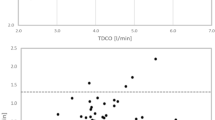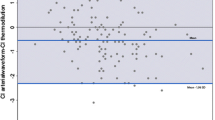Abstract
Objectives.This study was conducted to determine the response timeof the Opti-Q continuous cardiac output (CCO) device to a step change incardiac. Design.Prospective study. Setting.University hospitalanimal lab. Model.Female sheep. Interventions.In ten animals,cardiac output was altered suddenly by opening and closing a peripheralarteriovenous shunt to test the response time of the CCO system.Measurements and main results.Cardiac output was measured continuouslyby thermodilution and ultrasonic techniques while an arteriovenous shunt wasopened and closed. A total of 53 dynamic observations were made (5–6 peranimal). The mean response time of the continuous cardiac output device was86 seconds and was unaffected by the magnitude or direction of the change incardiac output. It was also unaffected by the animal's weight. CCOvalues were not statistically different from standard thermodilutionmeasurement (p= 0.895). Shunt flow ranged from 430 to 1730 ml/minand averaged 812 ml/min. The mean CCO with the shunt closed was 4.62 L/min.There was 1.5 to 2 minutes under or overshoot in cardiac output in 11% of themeasurements. Conclusions.Continuous cardiac output measurement wasas accurate as those made by standard bolus thermodilution. The averageresponse time to acute changes in cardiac output was approximately 1.5 minutesor ten times faster than previously reported systems. Response time isindependent of animal mass, shunt volume and the direction of cardiac outputperturbations.
Similar content being viewed by others
REFERENCES
Boldt J, Menges T, Wollbruck M. Is continuous cardiac output measurement using thermodilution reliable in the critically ill patient? Crit Care Med 1994; 22: 1913–1918
Burchell SA, Mihae Y, Takiguchi S. Evaluation of continuous cardiac output and mixed venous oxygen saturation catheter in critically ill surgical patients. Crit Care Med 1997; 25: 388–391
Haller M, Zoller C, Briegel J, Forst H. Evaluation of a new continuous thermodilution cardiac output monitor in critically ill patients: A prospective criterion study. Crit CareMed 1995; 23: 860–866
Lichtenthal PR, Wade LD. Clinical evaluation of a con-tinuous cardiac output system in post operative cardiac surgical patients. Crit CareMed 1993; 21: S214
Monchi M, Thebert D, Cariou A, Bellenfant L, Joly L, Brunet F, Dhainaut J. Clinical evaluation of the Abbott Qvue-OptiQ continuous cardiac output system in crit-ically ill medical patient. J Crit Care 1998; 13: 91–95
Yelderman ML, Ramsay MA, Quinn MD, Paulson RW, McKown RC, Gillman PH. Continuous thermodilution cardiac output measurement in intensive care unit patients. J CardiothoracVasc Anesth 1992; 6: 270–274
Hogue CW, Cerza RF, Rosenbloom M, Cappas DG. Comparison of continual thermodilution cardiac output with electromagnetometry. Anesthesiology 1993; 79 (3A): A467
Ditmyer CE, Shively M, Burns DB, Reichman RT. Comparison of continuous with intermittent bolus ther-modilution cardiac output measurements. Am J Crit Care 1995; 4: 460–465
Jacquet L, Hanique G, Glorieux D, Matte P, Goenen M. Analysis of the accuracy of continuous thermodilution cardiac output measurement. Intens Care Med 1996; 22: 1125–1129
Lazor MA, Pierce ET, Stanley GD, Cass JL, Halpern EF, Bode RH Jr. Evaluation of the accuracy and response time of STAT-mode continuous cardiac output. J CardiothorVasc Anesth 1997; 11: 432–436
Le Tulzo Y, Belghith M, Seguin P, Dall'Ava J, Monchi M, Thomas R Dhainaut J. Reproducibility of thermo-dilution cardiac output determination in critically ill patients: Comparison between bolus and continuous method. J Clin Monit 1996; 12: 379–385
Mihaljevic T, von Segesser LK, Tönz M, Leskosek B, Seifert B, Jenni R, Turina M. Continuous versus bolus thermodilution cardiac output measurements: A compa-rative study. Crit CareMed 1995; 23: 944–949
Scuderi PE, Bowton DL, Meredith JW, Harris LC, Evans JB, Anderson RL. A comparison of three pulmonary artery oximetry catheters in intensive care unit patients. Chest 1992; 102: 896–905
Scuderi PE, MacGregor DA, Bowton DL, James RL. A laboratory comparison of three pulmonary artery oximetry catheters. Anesthesiology 1994; 81: 245–253
Spackman TN, Abenstein JF. Continuous cardiac output may be more accurate than bolus thermodilution output during the use of an upper-body warming blanket. Anes-thesiology 1993; 79 (3A): A473
Wetzel RC, Latson TW. Major errors in thermodilution cardiac output measurements during rapid volume infu-sion. Anesthesiology 1985; 62: 684–687
Lazor M, Stanley GD, Cass JL, Pierce ET. Response time of STAT continuous cardiac output to an acute hemo-dynamic change. Anesth Analg 1996; 82: SCA71
Siegel LC, Hennessy MM, Pearl RG. Delayed time response of the continuous cardiac output pulmonary artery catheter. Anesth Analg 1996; 83: 1173–1177
Simon L, Brussett A, Roupie E, DuBois C, Fischler M. Continuous thermodilution cardiac output measurement: An evaluation in sheep. Anesthesiology 1993; 79 (3A): A466
Author information
Authors and Affiliations
Rights and permissions
About this article
Cite this article
Goldstein, L.J. Response Time of the Opti-Q Continuous Cardiac Output Pulmonary Artery Catheter in the Urgent Mode to a Step Change in Cardiac Output. J Clin Monit Comput 15, 435–439 (1999). https://doi.org/10.1023/A:1009934112134
Issue Date:
DOI: https://doi.org/10.1023/A:1009934112134




